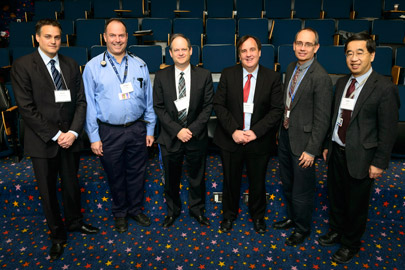A hearty showcase of cardiac care
By Eleni Kanavas
Scientists, clinicians and trainees attended the ninth annual Schulich Heart Program Research Day hosted by Sunnybrook Research Institute (SRI) on Nov. 24, 2014. Sunnybrook’s McLaughlin lecture theatre was filled to capacity as more than 150 research staff learned about cutting-edge research in cardiovascular medicine.
Dr. Michael Julius, vice-president of research at SRI and Sunnybrook, welcomed the attendees. “The Schulich Heart Program has been and continues to be exemplary in regards to the goal that SRI has established for itself,” Julius said. “Clinicians from every walk are interfacing shoulder-to-shoulder with biologists, physicists, engineers and clinical services researchers toward a single goal. We are inventing the future of cardiac care.”
Next, Dr. Bradley Strauss, a senior scientist in Biological Sciences and chief of the Schulich Heart Program at Sunnybrook, noted the day marks a celebration of achievement and is an opportunity for everyone in the program to see what others are doing and generate collaborative ideas.
Dr. Michael Farkouh, the Peter Munk Chair in Multinational Clinical Trials at the University Health Network, gave the opening keynote lecture. He spoke about how the University of Toronto aims to foster integration, innovation and impact in cardiovascular research and education.
Outcomes research
Opening the first session on cardiovascular disease management, Dr. Dennis Ko, a scientist in Evaluative Clinical Sciences and an interventional cardiologist at Sunnybrook, reported the results of a study he co-authored and published in Circulation. The aim of the population-based cohort study was to look at the trends in short- and long-term survival among out-of-hospital cardiac arrest patients transported alive to an emergency department in Ontario between 2002 and 2012.
He found patients that were transported to hospital alive had a significant increase in cardiovascular risk factors, but were less likely to have previous heart conditions. Survival rates increased significantly over the decade, Ko said, with younger patients showing the largest improvement.
Dr. Mark Peterson, a cardiac and endovascular surgeon at St. Michael’s Hospital, gave the second keynote lecture on new treatments for transcatheter aortic procedures in mitral valve disease.
Interventions in vascular treatments
During the second session on electrophysiology and surgery, Dr. Giuseppe Papia, an affiliate scientist in Evaluative Clinical Sciences, discussed endovascular interventions for saving the limbs of diabetic patients and improving their quality of life. He talked about the slow healing rates of diabetic foot ulcers, which have a 35% wound infection rate, and can take more than one year to heal.
“The comorbidities associated with a diabetic patient that’s going to develop a foot ulcer are immense. Their two-year mortality rate is closer to about 50%,” Papia said, noting that there is also significant functional recovery time.
Dr. Christopher Buller, director of cardiac catheterization and intervention at St. Michael’s Hospital, presented the final keynote lecture on the total occlusion study in coronary arteries, known as TOSCA-5, and the challenges in designing the trial. Strauss is leading the TOSCA-5 project and working with Buller and colleagues on the next stages of the development of collagenase to help clear blocked coronary arteries.
Innovation and market penetration
Wrapping up the event, Dr. Brian Courtney, a scientist in Physical Sciences, gave an update on activities to promote medical innovation at Sunnybrook and within southern Ontario. He reported that Canada is a net importer of medical devices, meaning it purchases more than it can produce and export. It is estimated that Canada buys about $6 billion worth of medical devices a year and exports $1.8 billion, compared to the U.S., which manufactures $100 billion worth of medical devices annually and exports more than $40 billion in such products.
“It’s very important for Canada to do the best it can to be an active participant in something that is important from an economic and social perspective,” he said about the translational work associated with the commercialization of medical technologies in the province.
At SRI, researchers are inventing medical devices within the Centre for Research in Image-Guided Therapeutics, which is equipped with a device development lab and tools to build new technologies, and gives scientists access to surgical suites and medical imaging systems.
Courtney also encouraged guests to attend the Schulich Innovation seminar series held monthly and next year’s research day, set for June 15. The Schulich Innovation Program aims to encourage entrepreneurship among clinicians and researchers, and give them a forum to share success stories and challenges. The program is run in conjunction with the Schulich School of Business at York University.
Dr. Graham Wright, director of the Schulich Heart Research Program at SRI, thanked the organizers and all who attended. “It’s been a really exciting day to see the amazing work that goes on here. The work in the program is state-of-the-art, there’s a strong translational focus and finally, it’s entirely collaborative.”







